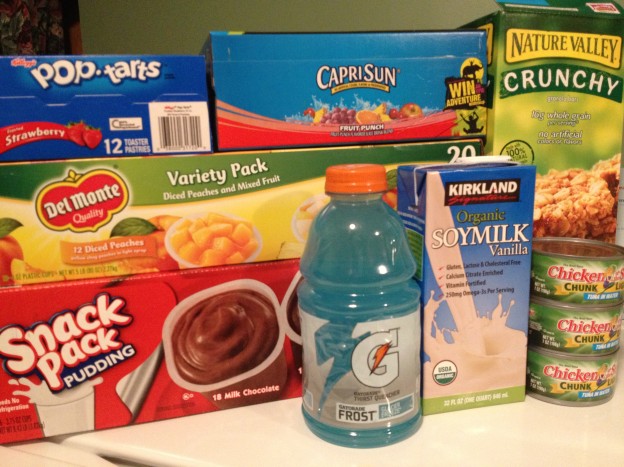Storms can strike at any time. Are you prepared? Here are some things you can do to ahead of time to make your household ready.
1. Determine the safest location to ride out the storm
Tornado – go to the lowest level of house, preferably your basement. Otherwise select an interior room without windows. Many people opt for the tub in the bathroom. Just try to bring a small mattress or comforter to protect yourself from any debris. For more information about preparing for a tornado: http://www.ready.gov/tornadoes
Hurricane / Thunderstorm – go indoors. You’ll want to be inside a safe structure. In case of a severe hurricane, listen for evacuation notices.
Lock Down – There is a remote chance you may need to stay in your house for an unexpected amount of time, due to a danger in the community.
Our Safe Area: When a storm is on the way, we head to our basement which is partially finished. There’s a couch, tv, area rug and a few supplies to tide us over.
For more information on documenting your Family Emergency Plan: http://www.ready.gov/sites/default/files/FamEmePlan_2012.pdf
2. Prepare your “Safe Area”
- Do you have any extra furniture and a basement? If so, set up a small living room with a couch, chair, and tv as your “Safe Area.”
- You’ll also want to have additional supplies on hand, such as blankets, pillows, flashlights, and a weather radio.
- Just in case the storm is a lengthy one, have a few things to do to pass the time: books, magazines, and card games.
- Lastly, you’ll want to have a plastic bin with your food supplies.
For an Emergency Supply List: http://www.ready.gov/sites/default/files/documents/files/checklist_1.pdf
3. Establish an Emergency Food Bin
This section is so important. Many of us have set up a pantry with extra food supplies. However, are you prepared to eat three meals per day for three days or more? Take some time to prepare your Emergency Food Bin.
Start by taking a head count of the number of people in your home.
Next, set up a meal plan: What would you eat for each meal? Think of each person individually. Does anyone have any dietary restrictions or requirements? We’ve included a sample Emergency Meal Plan, as well as a blank form and shopping list for your personal use.
Emergency Meal Plan – Shopping List
Here are some menu ideas. They may not be the healthiest choices, but in a time of need, they will get us by.
Breakfast
- Pop tarts
- Granola bars
- Juice box / Capri sun
- Pudding cups
- Fruit cups
Lunch
- Crackers
- Peanut butter
- Bottled water
Dinner
- PB jelly sandwich
- Tuna fish
- Canned chicken
Snacks
- Graham crackers
- Apples
- Bananas
- Chocolate pudding cup
- Applesauce cups
Beverages
- Water
- Gatorade
- Juice boxes
Don’t forget to include:
- napkins
- manual can opener
- paper plates
- plastic bowls
- plastic forks, spoons and knives
When preparing your food supplies, assume you will lose power. That means you shouldn’t open your refrigerator or freezer.
What about coffee?
Can’t live without a cup of coffee? Not a problem if you’ve planned ahead. During the ice storm of 2011, cities in Southern New England lost power for a week or more. Here are some creative ways our friends and neighbors handled their need for caffeine:
- Heated water in a pan on gas grill; made instant coffee
- Heated water in pan over an open fire; used a coffee press to grind fresh coffee beans
- Made friends with a neighbor who had a generator
- Drank soda with caffeine
- Went without coffee; headed to the coffee shop as soon as it opened
Before the Storm
Now that you’re prepared, here are some things to do when you hear that bad weather is headed your way:
- Fill cars with gas. If power goes out for a few days, you may not be able to fill up.
- Eat food in fridge and freezer.
- Have some cash on hand.
- Go grocery shopping for essentials: bread, fruit.
- Charge all devices – cell phone, laptops, iPads.
- Secure or put away yard items.
If weather is expected to be severe and widespread, consider leaving the area. We went to Niagara Falls to ride out Hurricane Irene. We had two young children and a roof that popped a leak two days before the storm. We covered the roof with a tarp, packed up our things, and left town. It was nice not to have to worry about the storm, which impacted most New England states.
Start planning today, so that your household will be prepared for a storm.

